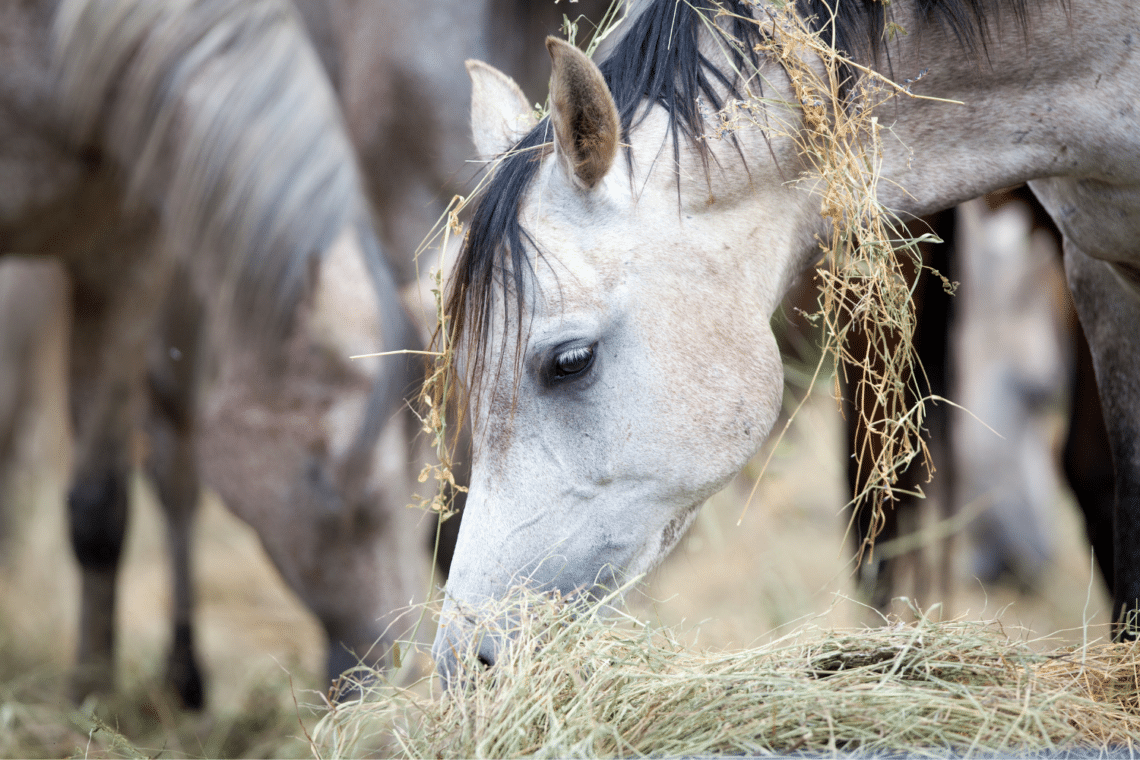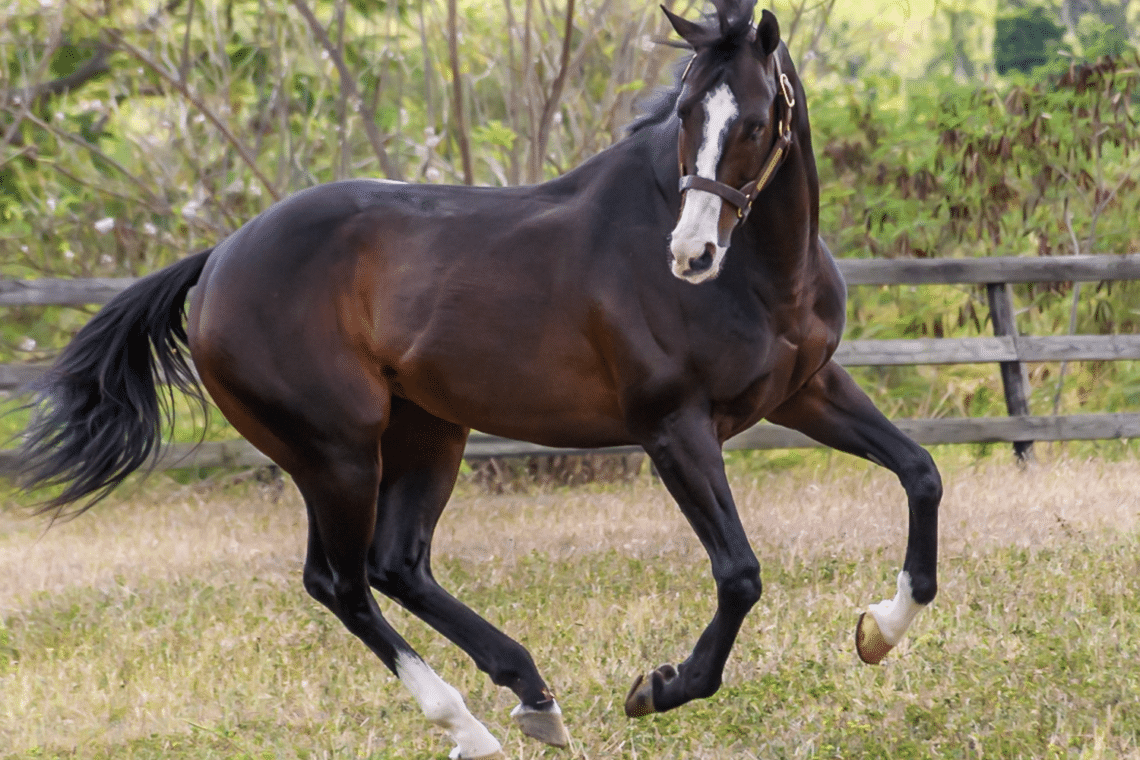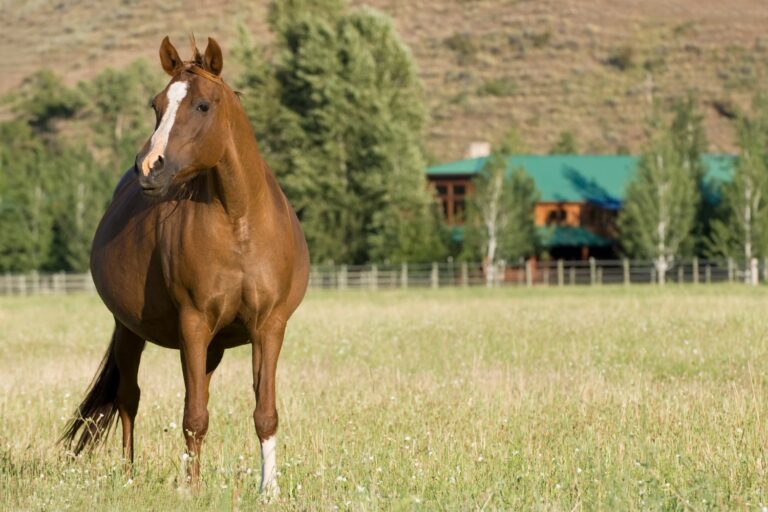Dr Clarissa Brown-Douglas, Kentucky Equine Research, discusses feeding the pregnant mare and stallion during winter in preparation for breeding and foaling out the other side.
Spring is fast approaching. Soon paddocks will be flush with green and foals will be frolicking. However, a healthy mare, foal, and breeding stallion doesn’t happen by chance, and now, in the depths of winter, is the time to focus on some key aspects of nutrition to ensure all is well for the upcoming season.
Pregnant mares
In the first five months of gestation, the mare can be happily maintained on her usual diet provided it is nutritionally balanced and she maintains her body weight. This is because the growing foal is very small during these early months of pregnancy. Even at seven months of pregnancy, the foal equals only about 20 percent of its weight at birth, which is less than two percent of the mare’s weight. During this time the foal’s nutrient requirements are miniscule compared with the mare’s own maintenance requirements. Therefore, the mare can be fed essentially the same as if she were not pregnant at all. All too often the well-meaning mare owner greatly increases feed intake after the mare is pronounced in foal, reasoning that she is now “eating for two.” This is not only unnecessary, but may lead to obesity and problems at foaling time.
Feed, but don’t overfeed or underfeed.
Mares have increased energy (calorie) needs from about six months of gestation through to birth. Mares are expected to gain approximately 12-15% of their initial body weight during pregnancy, most of which typically occurs in late gestation (nine to eleven months). By the last month of pregnancy, an average mare will consume roughly 20-22% more calories over maintenance needs.
Mares that are too thin throughout pregnancy may have a prolonged gestation period and have depleted nutrient stores. For mares that require the extra calories, a higher intake breeding feed should be fed along with high quality roughage. Mares that are over weight can be maintained on a low-intake concentrated balancer pellet and roughage.
Protein, vitamin and mineral balance.
Protein and mineral requirements increase to a greater extent in late pregnancy. This is because the foetal tissue being synthesised during this time is quite high in protein, calcium and phosphorus. Trace mineral supplementation is also very important during this period because this is the key period in which the foal stores iron, zinc, copper, and manganese in its liver for use during the first few months after it is born. The foal has developed this nutritional strategy of storing trace minerals during pregnancy because mare’s milk is quite low in these elements. Mares in late pregnancy are often overfed energy in an attempt to supply adequate protein and minerals to the developing foal. If the pregnant mare becomes fat during late pregnancy, she should be switched to a feed that is more concentrated in protein and minerals so that less can be fed per day. This will restrict her energy intake while ensuring that she receives adequate quantities of other key nutrients.
Targeted supplementation of mares.
Over the years nutrition researchers have identified a few key nutrients which should be considered with feeding your pregnant mare including natural vitamin E and long-chain omega 3 fats.
Vitamin E to boost colostrum quality
Studies show that supplementing pregnant mares with natural vitamin E prior to foaling can boost the levels of infection-fighting proteins called immunoglobulins. It is important to note that natural vitamin E is 5 times more bioavailable than synthetic forms of E, so make sure you read the label on the supplement! Natural E is d-alpha tocopherol, synthetic is dl-alpha tocopherol.

Long chain omega-3 fats
Like vitamin E, supplementing pregnant mares with long chain omega-3 fatty acids also appears to improve the quality of colostrum. In fact, offering marine-derived omega-3 fats (DHA and EPA) packs colostrum with more than just immunoglobulins, they also increase docosahexaenoic acid (DHA) levels in milk.
Take care of the gut
As with all class of horse, pregnant mares are not immune to gastric disturbance. However, as many of the common gastric ulcer medications are not fully evaluated for pregnancy, prevention is better than cure. These measures include access to plenty of forage, minimising environmental stress, and avoiding high-starch and high-sugar feed. Use of a research-proven digestive supplement as part of an overall management program can support both foregut and hindgut health.
Breeding stallions
But it’s not all about the mare – our stallions need carefully planned nutrition leading up to the breeding season. Maintaining a stallion in appropriate body condition tops the list of nutritional concerns for stallion managers. Too often, stallions become ribby because of breeding efforts or anxiety, or obese due to spring grass and inactivity.

Body Condition
Priming a stallion’s weight for breeding season starts well before the first mare of the year arrives. Like all horses, stallions are individuals and should be fed with their specific metabolism in mind. Some stallions can maintain weight throughout the year on forage and a ration balancer, even when covering many mares, while others can get so worked up about breeding that they melt away their fat reserves.
For stallions that maintain weight during breeding season, starting the season with a body condition score (BCS) of 5 or 5.5 (out of 9) is ideal. On the flip side, for stallions that drop weight as the breeding season progresses, beginning the season with a BCS of 6.5-7 may be the only way to keep the stallion in reasonable weight. During the breeding season, weight should be monitored weekly and appropriate dietary adjustments made.
Obesity is no ally for a stallion. Repercussions of excessive body weight are numerous: diminished libido, subfertility, increased strain on the joints of the hindquarters, and possible cardiovascular issues. When chronically over-conditioned, stallions may not have the stamina to breed a full book of mares.
Diet Considerations
Matching dietary energy intake with energy expenditure is the way to control body condition. Stallions have greater energy needs than mares and geldings, even when they’re not breeding. Circulating hormones can influence metabolic rate and cause stallions to have a higher energy requirement at maintenance than other horses.
Above all, the stallion diet should provide ample amounts of a good-quality forage. Additional caloric needs can then be met through the use of a concentrate. For those easy keepers, the concentrate may be a balancer, which will balance the nutrients found in forage. Others need larger amounts of a well-fortified, breeding feed to maintain weight. In choosing a feed, adequate but not excessive protein is important, as the requirement for protein increases only slightly with breeding and is usually covered by the increase in feed intake.
Targeted Supplementation of stallions
Stallions must be fed well to fuel spermatogenesis and to ensure breeding success. In addition to good-quality forage and well-fortified concentrates, researchers have identified certain nutritional supplements that improve semen.
Long chain omega 3 fats
One supplement widely used in breeding stallions around the globe is fish oil, due to its favourable long chain omega-3 fatty acid profile (DHA and EPA). Research has made clear the benefits of DHA for stallions, particularly with regards to semen quality in collected and cooled semen. It is important to note that DHA won’t make an infertile stallion fertile, but it can help with diminished motility.
Superior antioxidant support with coenzyme Q10
Researchers have recently investigated the possible role of the antioxidant, coenzyme Q10 on improving semen quality in stallions. Coenzyme Q10, commonly added to semen extenders, is an important cofactor in energy supply for spermatozoa and is responsible, in part, for motility.
In a group of sub-fertile stallions supplemented with 1g of coenzyme Q10 per day for 30 days, total motility, progressive motility, and sperm viability improved following 24 hours of cooling. The same held true for frozen semen from these stallions. When coenzyme Q10 was supplemented to stallions with superior spermatozoa motility, no further improvement was seen in motility, however spermatozoa viability improved.
Based on these observations, it would be beneficial to consider daily oral supplementation with coenzyme Q10 especially if a stallion has questionable fertility.
In summary
Targeting nutrition of both the mare and the stallion in the winter months can lead to a successful breeding season. Nutrition can play a significant role in the fertility of both mares and stallions, and the successful growth and development of the foal. As with all horses, it is highly recommended to seek the guidance of a qualified equine nutritionist to tailor a balanced diet for your horse’s individual needs.
About Dr Clarissa Brown-Douglas

Originally from New Zealand, Dr Clarissa Brown-Douglas has ridden all her life. As a young adult she was a keen eventer, but her career as an equine nutritionist with Kentucky Equine Research (KER) intervened, and for several years she lived and worked in the US. She then moved to Melbourne, which was her base while she travelled the world working with horse owners, breeders and trainers providing nutrition advice for their equine athletes.
Still with KER, Clarissa now lives in Bendigo, Victoria, along with her family and Pi, her beautiful German Riding Pony x Thoroughbred.



